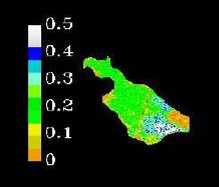Remotely estimation of nutrients concentration in the water column has been a very difficult task, especially in the tropics. However, that did not stop the doctoral student of civil engineering, Luis Campos, to conduct a research in this field. Actually he successfully defended the dissertation on December 4, 2009. The project was entitled “Identifying Total Phosphorus Spectral Signal In A Tropical Estuary Lagoon Using An Hyperspectral Sensor And Its Applicaton To Water Quality Modeling”. This project was conducted by the guidance of Fernando Gilbes and the financial support of the Puerto Rico Water Resources and Environmental Research Institute through the GERS Lab. The study site was the San Jose Lagoon (SJL), which is located in the northern coast of Puerto Rico. In February, May, and August, 2006, the Hyperion hyperspectral sensor collected images over SJL while field data was collected. A reflectance determination coefficient of 0.49 was obtained from the 467 to 529 nanometers bands ratio values, from which a polynomial algorithm was derived and used to produce a total phosphorus distribution map. While it is recognized that TP has no unique reflectance spectral signal (which can be confused with reflectance from other water constituents) this study demonstrates the application of total phosphorus possible spectral indexes to monitor its content in eutrophic tropical lagoons though a hyperspectral sensor. Luis research opens the door to future studies in this topic.

Category: Students






